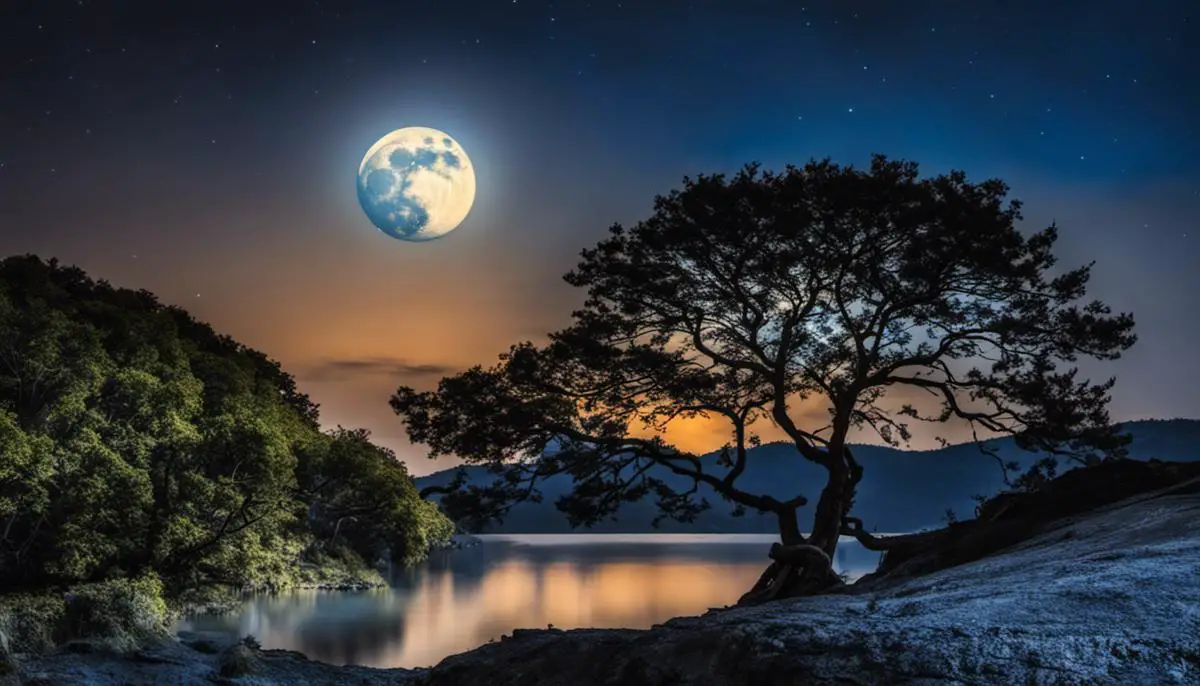When we gaze up at the night sky, the comforting constant is often our Moon. Its glow guides our nights and marks the passage of time. But every so often, unique phenomena alter the common moon we know, namely the concepts of Blue Moon and Green Moon. These captivating celestial events, although differing drastically in science and society’s comprehension, prompt an intriguing exploration. The following discourse examines the significance and science behind the Blue Moon, followed by an inquiry into the contradictions and misconceptions surrounding the Green Moon. From observing the lunar cycle and light refraction to assessing social narratives influenced by folklore, popular culture assistance in magnifying misconceptions, considerable ground will be covered, inviting you to embark on this enlightening stargazing journey.
Understanding The Phenomenon Of Blue Moon
Throughout the annals of history, man has turned a captivated eye toward the sky, piecing together constellations and seeking to unpick the enigmatic skein of our universe. Among the many celestial phenomena that have piqued human interest, the occurrence of a “Blue Moon” resides as a concept both distinctive and somewhat abstruse. The term ‘Blue Moon,’ ubiquitous in popular culture and song lyrics, bears a precise interstellar definition and a fascinating astronomical origin. This essay seeks to elucidate this intriguing occurrence, highlighting its unusual characteristics, and deconstructing the mechanics behind this infrequent spectacle in our night sky.
The term ‘Blue Moon’ might evoke a notion of the Moon appearing the hue of a blueberry on select evenings, yet this is rather a misapprehension. In essence, a Blue Moon designates neither a color transformation nor any physical alteration to the Moon. Instead, it refers to an additional full moon that appears within a specific timeframe, rendering it a chronological anomaly rather than a visual spectacle.
For the most part, every calendar month is graced with a single full moon. This pattern corresponds with the lunation cycle, the period it takes the Moon to orbit the Earth, which is approximately 29.5 days. However, since the Gregorian calendar measures most months as slightly longer than this cycle, occasionally a month can harbor two full moons. This additional full moon, the second in a calendar month, is what is colloquially termed as a ‘Blue Moon.’
Statistically, this phenomenon unfurls every 2.5 to 3 years, which aligns with the old saying ‘once in a blue moon,’ implying a rarity of events. Moreover, there is a seasonal modification to this definition, pinpointing a ‘Blue Moon’ as the third moon in a season that features four instead of the typically observed three.
The term ‘Blue Moon’ surfaced as early as the 16th century, but it didn’t hold the same scientific import as it does now. It was initially a colloquial term denoting absurdity, akin to saying ‘when pigs fly.’ The astronomical definition can be traced back to the March 1946 issue of Sky & Telescope magazine, where an article misinterpreted the Maine Farmer’s Almanac and defined a ‘Blue Moon’ as the second full moon in a calendar month. Despite its inaccuracy, this definition assimilated into popular vernacular and still holds fort today.
In conclusion, ‘Blue Moons’ serve as distinctive markers in man’s relentless tryst with decoding the cosmos. Their presence underlines the beautiful tapestry of celestial phenomena, weaving science, linguistics, and cultural expression onto one canvas. Despite its misleading name, the ‘Blue Moon’ is not a spectacle for our eyes, but a tantalizing delight for the diligent chronologists of space and time. Regardless of its color, every full moon whispers tales of space exploration, stargazing, and man’s insatiable curiosity towards the boundless universe that cradles us. After all, is in these orbs of night that we comprehend our existence as stardust in this cosmic labyrinth.
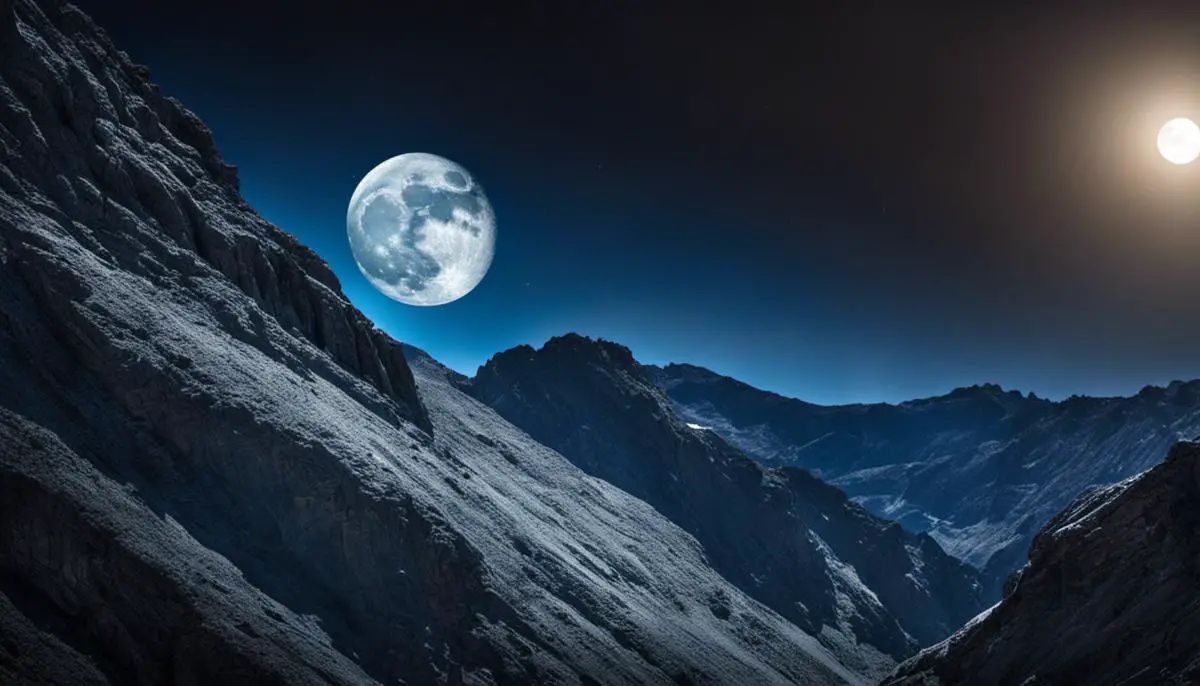
Incidence, Frequency & Cultural Implications of Blue Moons
Moving our focus from the theoretical perspective to the cultural implications, it is striking to note the widespread fascination with the Blue Moon phenomenon. Blue Moon occurrences have persistently remained at the centre of human spectacle, encirculating numerous cultures and communities worldwide. This ubiquity can in part be attributed to the inherent rarity of the event, creating a sense of marvel and wonder.
In many cultures, Blue Moons maintain a mystical aura, often being associated with love, desire, and unfulfilled wishes. Literature, poetry, and songs are not immune to the allure of the Blue Moon, leveraging it as a metaphor to express sentimental states often tied to longing and desire. Seemingly, the temporal irregularity seems to serve as a reflection for such human sentiments; just as our yearnings may not always align with reality.
Moreover, calendrical systems based on lunar cycles have shaped the way societies understand time. In essence, the Blue Moon acts as a corrective factor in reconciling solar and lunar calendars. This ‘extra’ moon has historically signified a time of imbalance, urging societies to recalibrate their routines. It provides a subtle reminder of the inconsistency of human-made systems in the face of a more complex, natural order.
Popular culture isn’t aloof from Blue Moon influences either. The phrase “once in a blue moon,” implying a rare event, has indeed been adopted in everyday English, underscoring the cultural relevance of this celestial event far beyond the realm of astronomy. It is no surprise then that the Blue Moon, unlike other astronomical phenomena, finds a cherished place in common parlance, emphasizing its cultural impact.
Blue Moons, much like other full moon phases, carry a rich tapestry of symbolism. Across cultures, full moons represent completion, fulfillment, and the realization of desire. The Blue Moon, in particular, magnifies these themes due to its infrequent occurrence. It is seen as a potent time for reflection, release, and the cultivation of personal growth—a time to contemplate one’s place in the greater cosmic order.
In conclusion, the Blue Moon serves not only as an intriguing astronomical occurrence but also as a sturdy bridge between science and sentiments, between celestial movements and cultural connotations. It stands as a testament to humanity’s quest for finding meaning amid the complexities of the universe—a shift from mere astronomical curiosity to culturescape embodiment. The Blue Moon truly embodies the intrigue, beauty, and mystery that our universe has to offer.
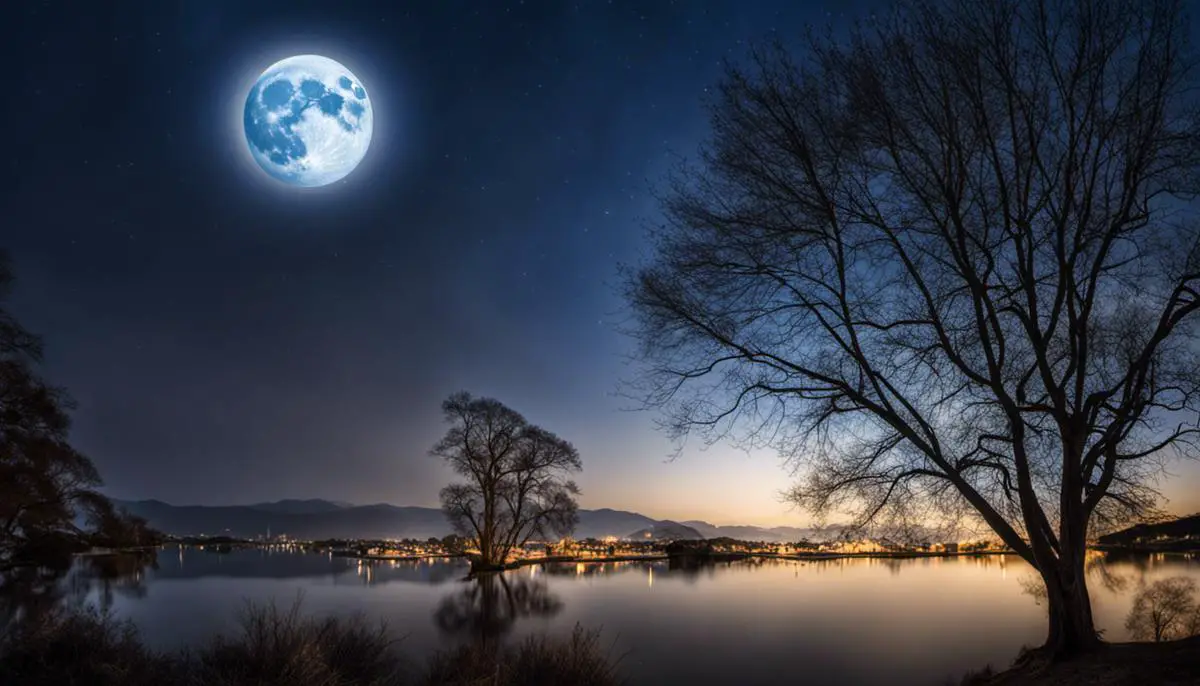
Green Moon: The Science and Fallacy Behind
As we delve further into the cosmos, we encounter the term ‘Green Moon’. The phrase undoubtedly sits comfortably alongside its counterpart ‘Blue Moon’, stirring up an air of intrigue. Let us explore whether a ‘Green Moon’ also has scientific credibility or if it is simply steeped in mythology and folklore.
On consultation of the gamut of authoritative astronomical literature, it is quickly discovered that no definitive scientific source recognizes the ‘Green Moon’ as a genuine celestial event. The moon does not turn green during specific cycles or under any unique conditions. This firmly categorizes the ‘Green Moon’ as a myth rather than a scientific reality. However, the curiosity is – where does this myth stem from?
The concept of a ‘Green Moon’ primarily flowers from internet-based folklore, fueled by sensationalist posts and popularity on social media. The green hue in the lunar description is not rooted in any astronomical phenomena, but instead represents a miscommunication exploited with digital artistry. There have been claims of a ‘Green Moon’ appearing on April 20, associating it with the 420 code in cannabis culture. The viral posts drive creating a sense of marvel among the uninitiated, but they are devoid of factual accuracy.
Contrarily, it is factually correct that atmospheric conditions can sometimes cause the moon to appear different colors, including green. This, however, is not unique to the moon but is related to Rayleigh Scattering – an optical phenomenon that affects the color of all celestial bodies, including the Sun. Tiny oxygen and nitrogen molecules scatter short-wavelength light, such as green or blue light, to the far corners of the sky, while long-wavelength light such as red, orange, or yellow are least affected and often colors the moon and sun we observe. But particular green tint in the moon is extremely rare and is never as saturated as the ‘Green Moon’ memes suggest.
Exploring the ‘Green Moon’ bares testament to our never-ending enchantment with the night sky. What’s intriguing is not the misinformed myth, but the fact that a simple phrase could generate such buzz and cause us to look up, notice and ponder about our celestial companion. After all, the chronicling of the moon’s phases is closely bound to human history, intertwining the scientific, cultural, and spiritual elements of our existence. It is an astronomical phenomenon imbued with symbolism and mysterious beauty that has always captured the depths of our curiosity.
In conclusion, although the ‘Green Moon’ is not a scientifically endorsed phenomenon, it highlights the enduring impact of our moon on our collective imagination, the unquestionable human penchant for myths and stories, and the importance of disseminating accurate scientific information.
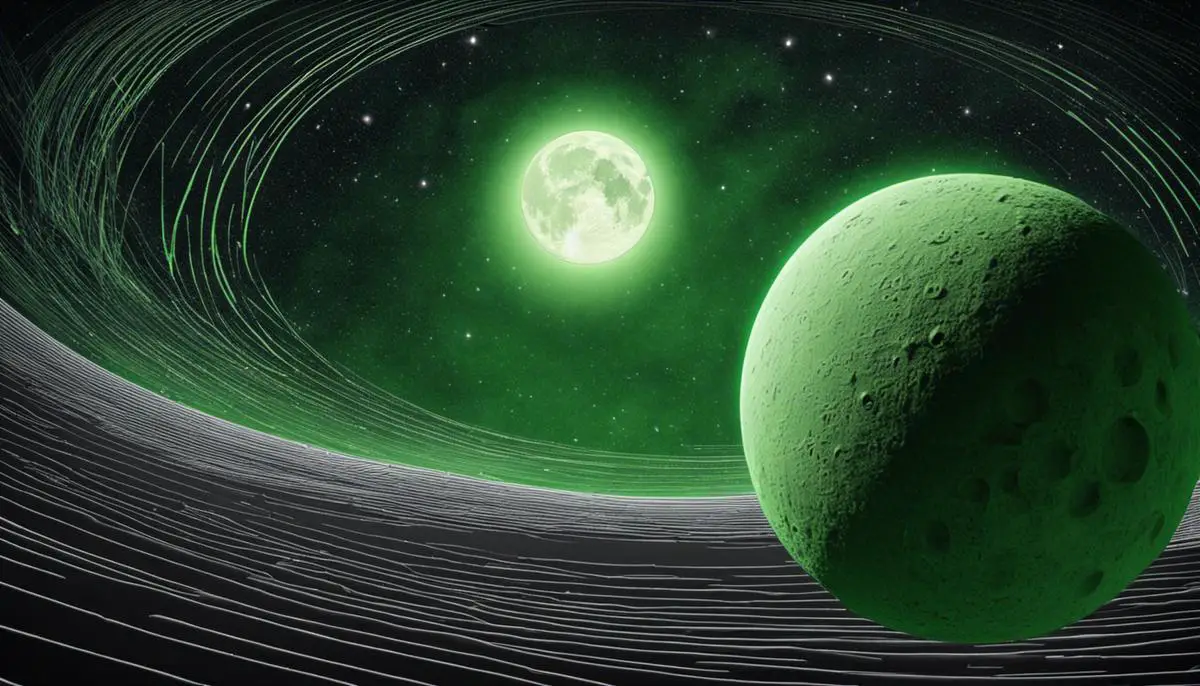
Green Moons: Societal Perception and Misconceptions
The concept of the Green Moon, much like its Blue Moon counterpart, has wielded considerable influence over societies, yet it is shrouded in a host of misconceptions. The surge of the term ‘Green Moon’ primarily stems from internet folklore and fictitious claims, gaining popularity as a myth.
The notion of a Green Moon lacking scientific credibility is often met with an air of surprise. Unlike the Blue Moon, the Green Moon is not recognized as a celestial occurrence in astronomical terms. This prototype has its roots embedded in sensationalist online posts and rumors that quickly diffuse across the internet’s global network, proving the potent role that cyberspace plays in sculpting societal beliefs.
An interesting facet of the Green Moon myth is its affiliation to the ‘420’ cannabis culture. Various social media platforms have propagated the narrative that a Green Moon, resembling the emerald hue of cannabis, would grace the skies on April 20 in honor of the unofficial holiday celebrated by cannabis enthusiasts. This connection of a celestial phenomenon to a subculture further elucidates the power of folklore in driving narratives that traverse different societal segments.
A critical point to consider, which often fuels the misconception of the Green Moon, is the alteration of the Moon’s apparent color due to atmospheric conditions. Indeed, our Moon can adopt various shades, including a hint of green, as a result of the scattering and diffraction phenomena occurring in the Earth’s atmosphere. However, a full moon drenched in an intense green hue, as often conveyed in internet memes, is exceedingly rare, if not impossible.
The persistence of the Green Moon myth may be a testament to humanity’s unceasing fascination with the cosmos. The distinct cultural footprint of the Moon across various civilizations, symbolizing myriad elemental aspects such as time, unity, or fertility, is a clear indicator of its timeless influence.
A pivotal aspect to underscore in discussing the Green Moon, or any celestial phenomenon, is the crucial role of accurate scientific information. The potential for myths to skew public perception is high, which underlines the need for robust scientific communication to debunk such inaccuracies and reinstate empirically-backed knowledge. By fostering a public understanding of science that is both clear and correct, the pursuit of knowledge continues, untainted by fallacies.
In summary, while the Green Moon commands attention and intrigue much like the Blue Moon, distinguishing the line between fact and fiction is paramount. The enduring appeal of exploring lunar events signifies a relentless pursuit of knowledge, demonstrating the interplay between scientific understanding, societal beliefs, and the powerful emotion of wonder ignited by the cosmos itself.
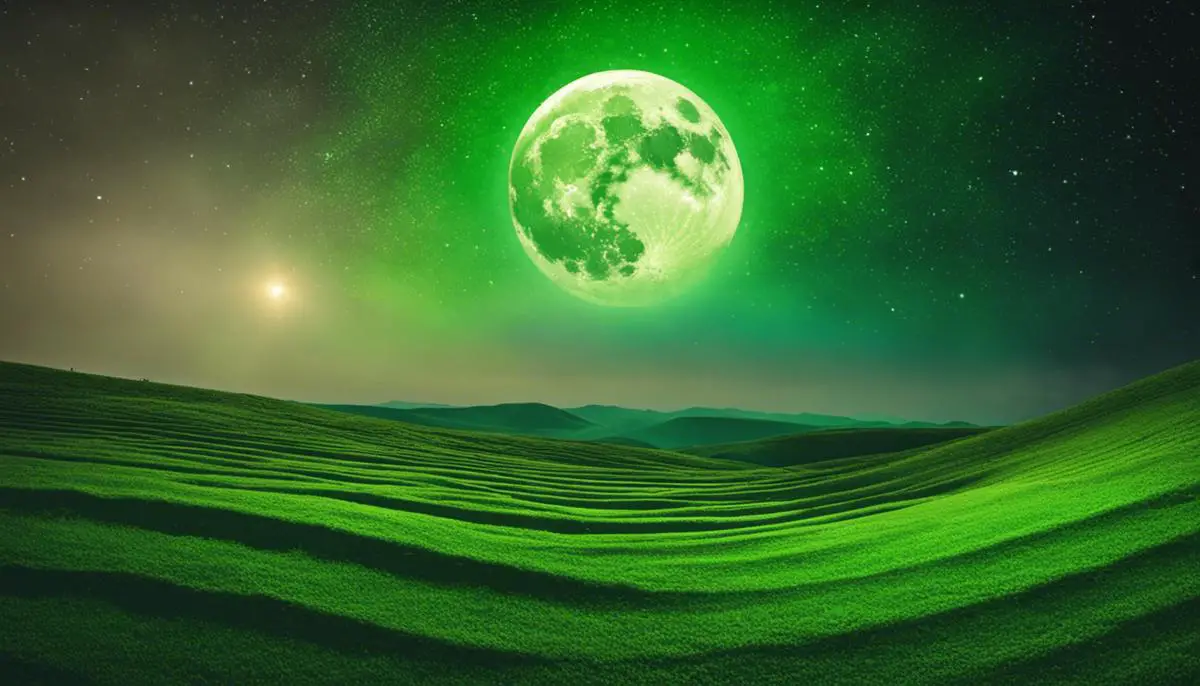
Our journey through the lore and science of lunar spectacles concludes here, but the observations and knowledge we’ve gathered illuminate a new perspective of the night sky. The enchanting Blue Moon has been understood beyond its hue, to be about the unpredictability portraying the charm of nature and human fascination, while the illusory Green Moon imparts valuable insight into the power of misinformation and the humility in recognising fallacies. Moreover, these celestial occurrences serve as poignant reminders of the enchantment that stellar phenomena hold within our societal and cultural narratives. So, the next time we look upon the moonlight, it won’t be just a luminary in the dark sky. Instead, it becomes the embodiment of the wonders and enigmas of the cosmos, the confluence of science and societal beliefs, charging us with the desire for ceaseless exploration and learning.
![]()
